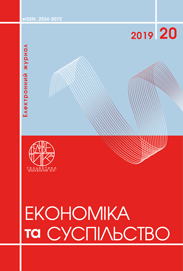THE ESTIMATION OF THE ECONOMIC EFFICIENCY OF INFORMATION SYSTEMS OF THE COMMERCIAL ENTERPRISE AN INTEGRATED METHOD OF DIVIDING COMBINED ECONOMIC RESULT
Abstract
In recent times was invented many different technologies for evaluating the results of implementing information systems in an enterprise. But works, which devoted to the study of the economic efficiency in accordance with the task of equitable distribution of the combined economic result, needed to be studied more closely. In our view, initially, need formulating the generalized task of equitable distribution of the general result. This is achieved by minimizing the requirements for the characteristics of the contribution of participants to the achievement of the combined result. The separation based on the quantitative and qualitative characteristics of the contribution of participants to the combined result and consider the possible inequality of participants in terms of the possibility of achieving any result. The task of distribution, we specify by the next rates: the set of participants; total profit; the range of permissible values of parameters characterizing the contribution to the total profit; parameter values for each participant or group of participants; a vector that determines the significance of each of the parameters for profit. We have also set up the requirements for the solution of the problem are formulated, ensuring the fairness of the distribution from the point of view of the principle of “proportional equality”, which stipulates that the participant’s value corresponds to obtaining a result and its share in profits. These requirements are efficiency, symmetry, inalienability, monotony. To solve the generalized problem was constructed a combined method which depends on the properties of the parameters characterizing the participant's contribution to the overall result and allows to simultaneously consider the quantitative, qualitative and coalitional characteristics of the contribution of participants in joint activities. A combined method based on the identification of five main types of characteristics of the participants' contribution to the combined result. This selection allows for solving a wider range of separation problems than any of its standard methods.
References
Moulin H. Fair division and collective welfare. Cambridge and London: MIT Press, 2003. 289 p.
O'Neill B. A problem of rights arbitration from the Talmud. Mathematical Social Sciences. 1982. Vol. 2, № 4. pp. 345–371.
Мулен Э. Кооперативное принятие решений: Аксиомы и модели. М.: Мир, 1991. 464 с.
Peng L., Yaohua W., Na X. Allocating Collaborative Profit in Less-than-Truckload Carrier Alliance Journal of Service Science and Management. 2010. Vol. 3 № 1. pp. 143–149.
Печерский С. Л., Беляева А. А. Теория игр для экономистов. Вводный курс. Учебное пособие. СПб.: Изд-во Европейского Университета в Санкт-Петербурге, 2001. 342 с.
Forman E.H., Gass S.I. The Analytic Hierarchy Process An Exposition. Operations Research. The Institute for Operations Research and the Management Sciences, 2001. Vol. 49, № 4. pp. 469–486.
Саати Т. Л. Принятие решений при зависимостях и обратных связях: Аналитические сети. Москва: Издательство ЛКИ, 2008. 360 с.
Dalkey N.C., Helmer O. An Experimental Application Of The Delphi-method To The Use Of Experts. Journal of the Institute of Management Sciences. 1963. Vol. 9(3). pp. 458–467.
Gordon T. J. Report on a Long-Range Forecasting Study, Rand Report № P 2982 Santa-Monica, California: Rand Corporation, 1964. 76 p.
Moulin H. (2003) Fair division and collective welfare. Cambridge and London: MIT Press. 289 p.
O'Neill B. (1982) A problem of rights arbitration from the Talmud. Mathematical Social Sciences. Vol. 2, № 4. pp. 345–371.
Mulen E. (1991) Kooperativnoe prinyatie resheniy: Aksiomy i modeli. Mосква: Mir. 464 p. (in Russian)
Peng L., Yaohua W., Na X. (2010) Allocating Collaborative Profit in Less-than-Truckload Carrier Alliance Journal of Service Science and Management. Vol. 3 № 1. pp. 143–149.
Pecherskiy S.L., Belyaeva A.A. (2001) Teoriya igr dlya ekonomistov. Vvodnyy kurs. Uchebnoe posobie. SPb.: Izd-vo Evropeyskogo Universiteta v Sankt-Peterburge, 342 p. (in Russian)
Forman E.H., Gass S.I. (2001) The Analytic Hierarchy Process An Exposition. Operations Research. The Institute for Operations Research and the Management Sciences, Vol. 49, № 4. pp. 469–486.
Saati T. L. (2008) Prinyatie resheniy pri zavisimostyakh i obratnykh svyazyakh: Analiticheskie seti. Mосква: Izdatel'stvo LKI, 360 p. (in Russian)
Dalkey N.C., Helmer O. (1963) An Experimental Application Of The Delphi-method To The Use Of Experts. Journal of the Institute of Management Sciences. Vol.9(3). pp. 458–467.
Gordon T.J. (1964.) Report on a Long-Range Forecasting Study, Rand Report № P2982 Santa-Monica, California: Rand Corporation, 76 p.


